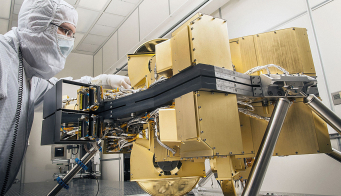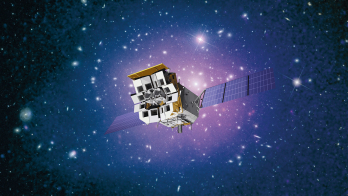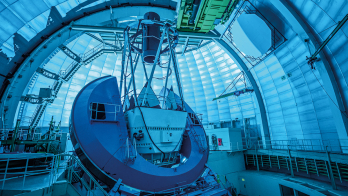
While it is believed that each galaxy, including our own, contains a supermassive black hole (SMBH) at its centre, much remains unknown about the origin of these extreme objects. The seeds for SMBHs are thought to have existed as early as 200 million years after the Big Bang, after which they accreted mass for 13 billion years to turn into black holes with sizes of up to tens of billions of solar masses. But what were the seeds of these massive black holes? Some theories state that they were formed after the collapse of the first generation of stars, thereby making them tens to hundreds of solar masses, while other theories attribute their origin to the collapse of massive gas clouds that could produce seeds with masses of 104–105 solar masses.
The recent joint detection of a SMBH dating from 500 million years after the Big Bang by the James Webb Space Telescope (JWST) and the Chandra X-ray Observatory provides new insights into this debate. The JWST, sensitive to highly redshifted emission from the early universe, observed a gravitationally lensed area to provide images of some of the oldest galaxies. One such galaxy, called UHZ1, has a redshift corresponding to 13.2 billion years ago, or 500 million years after the Big Bang. Apart from its age, the observations allow an estimate of its stellar mass, while the SMBH expected to be at its centre remains hidden in these wavelengths. This is where Chandra, which is sensitive in the 0.2 to 10 keV energy range, came in.
Observations by Chandra of the area of the cluster lens, Abell 2744, which magnifies UHZ1, shows an excess at energies of 2–7 keV. The measured emission spectrum and luminosity correspond to that from an accreting black hole with a mass of 107 to 108 solar masses, which is about half of the total mass of the galaxy. This can be compared to our own galaxy where the SMBH is estimated to make up only 0.1% of the total mass.
Such a mass can be explained by a seed black-hole of 104 to 105 solar masses accreting matter for 300 million years. A small seed is more difficult to explain, however, because such sources would have to continuously accrete matter at twice their Eddington limit (the point at which the gravitational pull of the object is cancelled by the radiation pressure it applies through the accretion to the surrounding matter). Although super-Eddington accretion is possible, as this limit assumes for example spherical emission of the radiation, which is not necessarily correct, the accretion rates required for light seeds are difficult to explain.
The measurements of a single early galaxy already provide strong hints regarding the source of SMBHs. As JWST continues to observe the early universe, more such sources will likely be revealed. This will allow us to better understand the masses of the seeds, as well as how they grew over a period of 13 billion years.
Further reading
Á Bogdán et al. 2023 Nat. Astron. doi:10.1038/s41550-023-02111-9.







